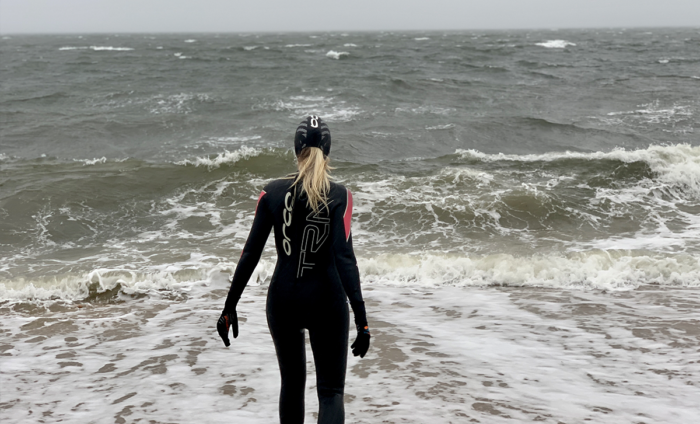
Open water safety tips from the RNLI
We speak to Samantha Hughes, National Water Safety Partner for the RNLI, for advice on how to stay safe in the water this winter
How has the RLNI reacted to the upsurge in people swimming outdoors over the past year?
With lockdown restrictions closing swimming pools and lidos for much of the year, and with many people not escaping on their usual trips abroad, we found more people taking to the beaches and countryside. As a result, we saw an increase in lifeboat call outs over the summer months and more people continuing to enjoy the water into the colder months too, particularly with swimming and dipping. Recently we shared a short video on the RNLI’s YouTube channel with our top tips for enjoying a cold water dip in the sea. You can watch it below.
The Maritime and Coastguard Agency saw a 52% increase in incidents involving swimmers over the winter months. Have you seen a similar story?
We’ve certainly seen an increase in people participating in swimming all year around and as a result our volunteer lifeboat crews saw a 14% increase in call outs during the summer months.
With more and more people swimming outdoors all year round, could we see lifeguarded beaches in winter?
We actually have one beach – Crosby in Merseyside – where RNLI coastguards operate all year round. This year, working alongside local authorities and landowners, we did increase the length of the lifeguard season on some beaches due to increased visitor numbers, so it’s something we constantly monitor and assess.
As well as heeding your safety advice, how can swimmers can keep themselves and others safe?
Always look out for fellow swimmers and dippers – take a means of calling for help with you and remember to call 999 if you or someone else requires help.
Consider downloading the RYA SafeTrx App (UK) or Irish Sailing SafeTrx App (Ireland). It can track your swim and alert emergency contacts if you fail to return home on time.
Have plenty of warm clothes for before you go in and when you go out. Be aware of the signs and symptoms of hypothermia, and what to do. The first signs of hypothermia can include confusion, loss of coordination and you will stop shivering becoming a lot more rigid. If you suspect that you or someone else is suffering hypothermia, call 999 for medical help. It is important not to actively warm up and by that I mean with a warm shower or hot drink. Instead, be gentle, remove any outer layers of wet clothing first, then use a blanket to warm up and a hat or something else to warm their head.
Do look out for local swim groups to join where you can share your experiences and consider taking a course or finding an open water coach to help you get the best out of your time in the water.
For more safety tips go to: rnli.org/safety/choose-your-activity/open-water-swimming or for information on cold water shock, rip currents and waves go to rnli.org/safety/know-the-risks
Top safety tips from the RNLI
Going for a swim in cold, open water can be exhilarating, but it’s not without risk. We want to make sure that everyone enjoys swimming safely, particularly in winter.
1. Be prepared
Check the weather conditions and tides – because this might affect your plans. Ensure you go to a familiar place and seek advice from a health care professional especially if you have underlying health conditions and are going to experience cold water immersion for the first time.
2. Never go alone
Always go with a buddy. Open water swimming/dipping has a fantastic community feel about it and it is much more fun going with someone else so you can look out for each other. It is also important to tell someone on shore your estimated timescale so they can call for help if you are overdue.
3. Acclimatise slowly to avoid cold water shock
It is important to enter the water slowly and allow time for your body to get used to the cold. Don’t jump or dive straight in, as this could cause cold water shock. Ways to do this are to splash your face, back of your neck and try not to hold your breath.
4. Always be seen
Wear a bright coloured swim hat and consider using a bright coloured tow float. We recently had a rescue by Sunderland RNLI’s lifeboat crew in challenging sea conditions where the swimmer was spotted in the sea thanks to their orange tow float. That meant he was located much sooner than he may otherwise have been, which could possibly have ended up saving his life.
5. Stay within your depth
This will reduce the chance of getting into trouble. Always swim parallel to the shore as the wind and currents can push you off course, and it is important to always keep an eye on your exit point.
6. Float to live
If you get into the water too quickly, you may experience cold water shock. If this happens, fight your instinct to swim. Relax and float on your back until you can control your breathing and the shock passes. If you tire while swimming or dipping roll onto your back to rest and hold onto something that floats, like your tow float. Then you can signal for help if needed.
Call 999 or 112 and ask for the coastguard if you get into difficulty or see someone else in trouble.
How can people support the RNLI?
As a charity, we rely on the kindness and generosity of people like you, to keep our lifesaving service going, so a big thank you. For more information on ways you can help us by donating either money or your time please visit RNLI.org/support-us.







